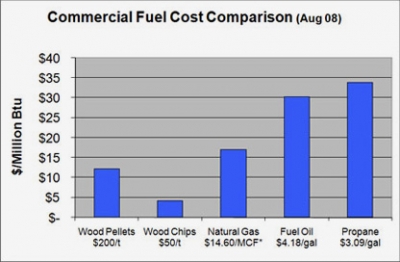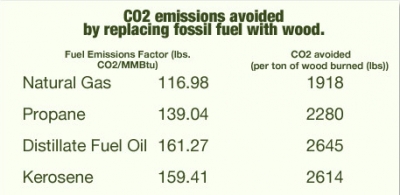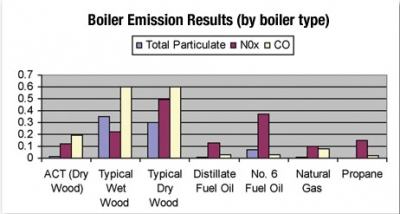Frequently Asked Questions
The chart below shows the relative costs of wood compared with other heating fuels as of July 2008.

Note that the residential customer price for natural gas is significantly higher at $21.61/million cubic feet.
Source: New York State Energy Research and Development Agency
Bioenergy is energy (ie. heat, electricity, or stored energy as transportation fuel) made from biomass (ie.organic materials such as wood and agricultural crop residues).
Wood pellets are typically made from sawdust and chips that are a by product of lumber production. The wood chips are ground and dried to 8-10% moisture and extruded to make pellets that are 1/4” diameter and ~1” long. Pellets are typically made from 100% wood without additives. During pellet manufacture, heat and pressure melts the lignin in the wood which then acts as a binder to hold the pellet together.
Although it takes energy to grind chips and to dry and extrude wood pellets, the total energy used is significantly less than to refine fossil fuels. The making of wood chips and wood pellets uses about 0.5% and 2% respectively of the total energy contained in the end fuel product. This is significantly better than fossil fuel energy sources where 10-12% of the energy contained in the fuel is used during the refining process. (Planning and Installing Bioenergy Systems: A Guide for Installers, Architects and Engineers, German Solar Energy Society, ECOFYS, 2005)
The key advantages of pellets are standardization and density. Pellets are a standard size, moisture content and certified to be free from contaminants. In Europe there are specifications and standard grades for wood fuel chips; however, in North America one has to work with a wood chip supplier to ensure chips of the right size, moisture content and quality. Pellets are typically four to seven times more dense than wood chips and shavings which helps optimize transportation and reduce storage requirements.
The emission of carbon dioxide (CO2) from fossil fuel burning is a major contributor to global climate change. When the wood is burned, or is simply left to decay in the forest, carbon dioxide is also released; however, growing trees and plants also absorb CO2. If wood is used at the same rate that it grows in the forest the system is sustainable and considered “carbon neutral” and not a net contributor to global warming.
Burning fossil fuels releases CO2 that has been stored underground for millions of years and increases the total amount of CO2 in the atmosphere and contributes to global warming. For every unit of fossil fuel heat replaced with wood the following chart shows the net CO2 emissions reductions.

(Source: The Climate Trust) Assume 8% moisture wood or pellets at 16.4 MMBtu/ton.
When wood is harvested locally and used as fuel, those heating dollars stay in the community for jobs in wood process and forest management. When fossil fuels are burned for heat, most of the money leaves the local community. We believe that clean renewable heating systems are a solid financial investment that supports strong local communities.
The use of wood wastes for fuel provides an alternative market for low value wood that previously was uneconomic to manage. Use of this waste wood for fuel can improve forest health by making more growing room for the remaining trees and can also eliminate the need for slash burning and/or reduce the forest fire risk in certain forest regions.
Our belief is that fossil fuels such as oil and natural gas are too valuable to use for heating buildings and should be conserved for uses such as transportation fuels where they can’t readily be replaced by solid fuels. Using wood and other biomass for heating is just common sense when wood is a locally available resource.
The ACT Bioenergy Boiler was specifically designed for use in commercial, institutional and multi-family residential buildings with heat loads 0.5-1.7 million Btus to either supplement or totally replace fossil-fuelled boilers.
The ACT Boiler is designed for customers are looking for a reliable, user-friendly system to reduce their heating costs while still achieving the highest environmental standards.
In North America, most wood burning boilers have been adapted from large industrial applications or from the wood processing industry which the customer needs are different that most building owners and managers.
European and particularly Austrian firms have been world-leaders in developing wood boiler technology specifically designed with the building manager in mind. ACT is the leader in refining this technology for use in North America.
Superior emission results and high efficiencies are achieved in boilers which ensure the correct control of combustion temperature, turbulent airflow and adequate residence time in the combustion zone. The ACT Bioenergy™ Boiler achieves this control by monitoring the boiler temperature and automatically adjusting the air and fuel supply in the combustion zone. Using a proprietary gasification process, the wood is first heated to release the volatile gases and then high velocity turbulent air flow achieves a complete, clean burn of all volatile gases.
Older boiler technology does not have the advanced two stage combustion design or controls to automatically adjust air supply to ensure complete, clean combustion. High boiler efficiency from the ACT Bioenergy Boiler (TM) means that less fuel is required to achieve the same heat output and also that the total amount of emissions are reduced compared with less effient older wood boilers.
The ACT Bioenergy Boiler’s emissions are comparable with emissions from fossil fuel boiler systems as seen below.

Notes: ACT emission data from independent European test lab results. Other boiler emission results from US EPA – AP42 standard emission data. Dry wood is <30% moisture content and wet wood is >30% moisture. http://www.epa.gov/ttn/chief/ap42/ch01/index.html
Gasification-type combustion, as in the ACT Bioenergy Boiler produces a clean burn from which there is no visible smoke. On cold days it may be possible to see white water vapor clouds from the stack; but this is common to any type of boiler.
Due to the optimized gasification system and the large heat exchanger surface area in the boiler, the ACT Boiler achieves measured efficiencies of 85-92%.
The ash from pellets can range from 0.2% to 1% for premium wood pellets to up to 3% for standard pellets or for wood chips. The ash is cleaned from the boiler internal surfaces falls down and is removed from the bottom of the boiler using augers and transferred into the ash collection bin. Typically it is necessary to empty the ash collection bin every 3-6 weeks.
The ACT Bioenergy Boiler is designed for maximum flexibility during installation. Its small size allows it to be delivered through standard double doors and the footprint is 70-90 ft2. and the boiler has a height of 6’ to 6’7”. In some cases this can fit within an existing boiler room, or it can be installed in a standard shipping container or purpose built external boiler room. There are also various fuel storage options - either internal or external to the building with transfer to the boiler through worm augers or pneumatic conveyors from bins or silos.
